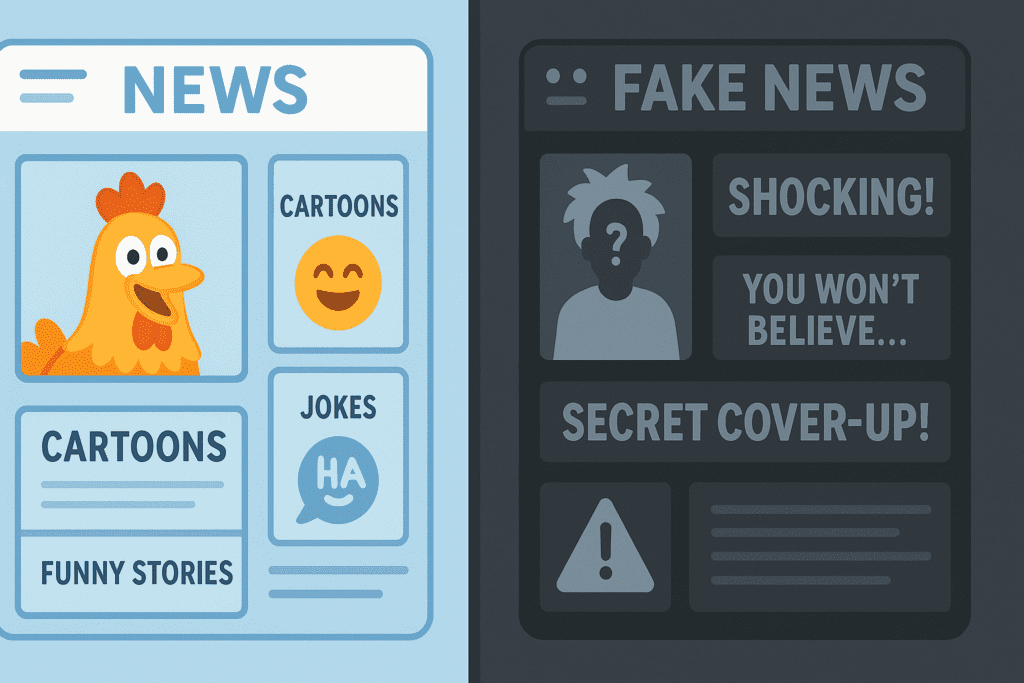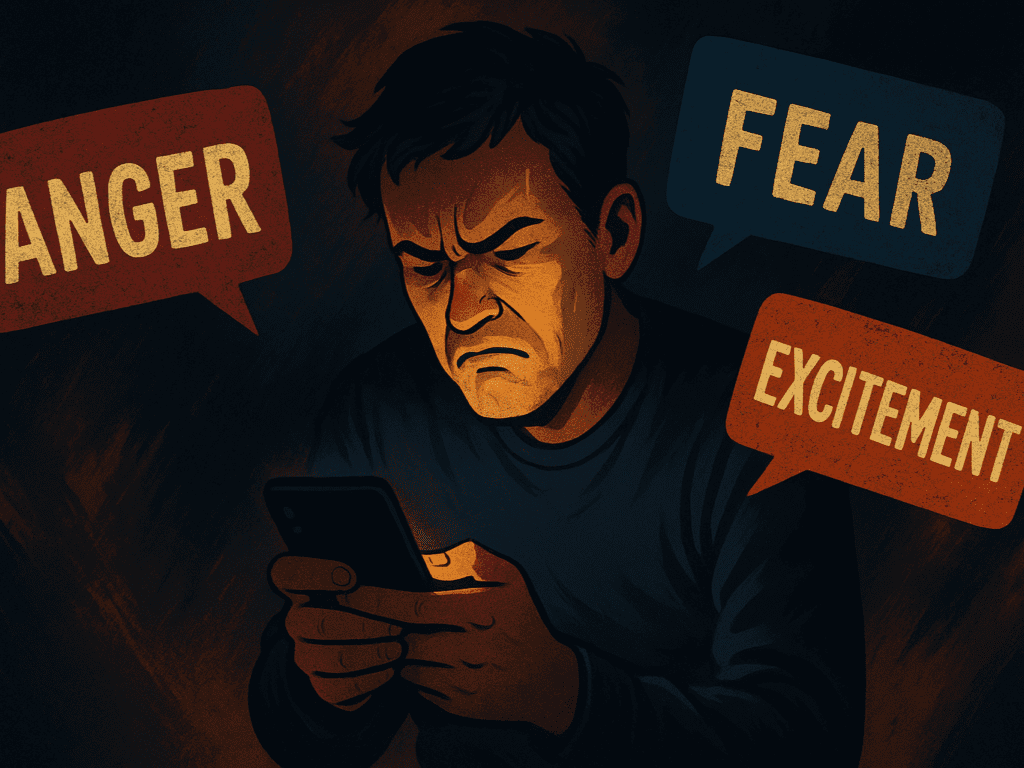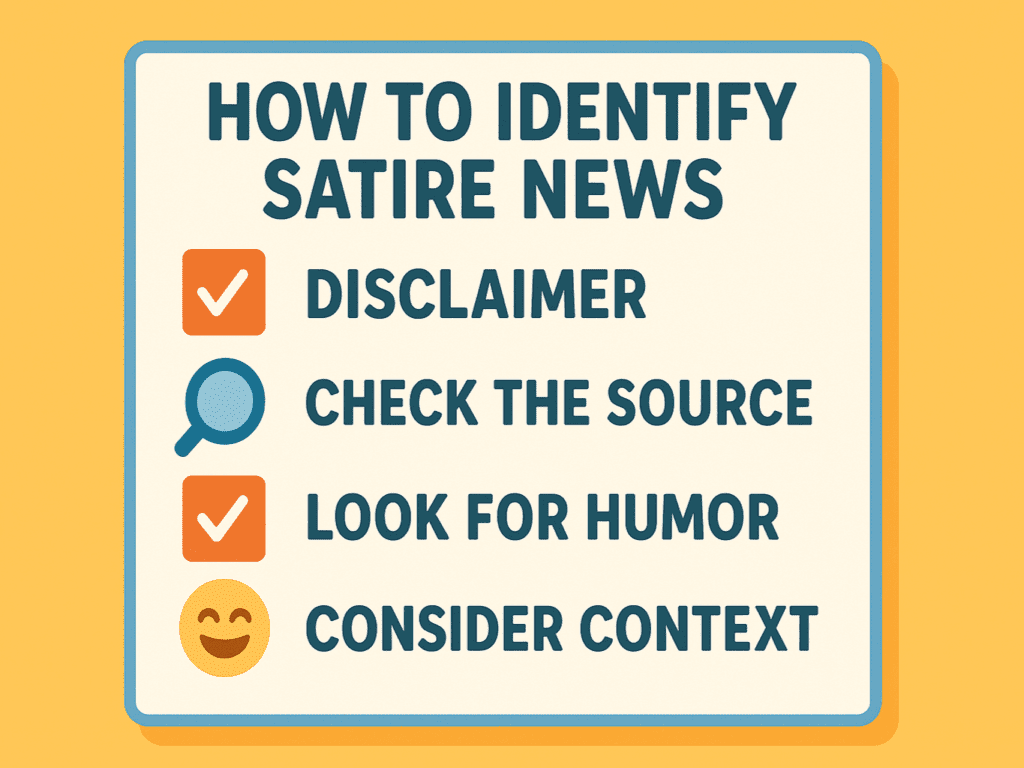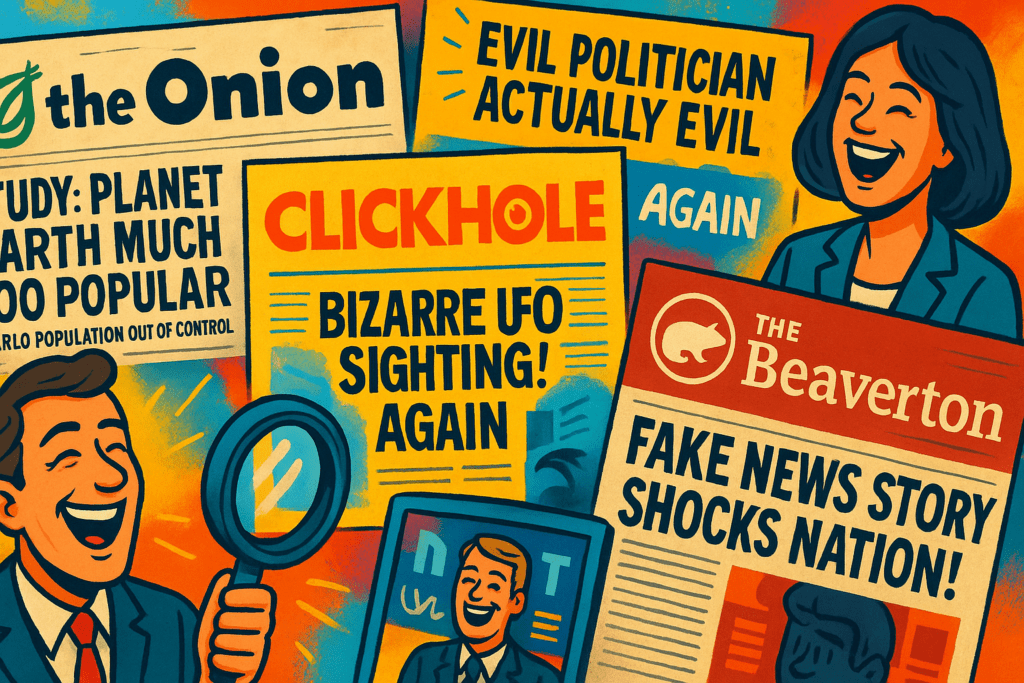The Onion, with its 11.6 million Twitter followers, stands as one of the most influential satire news websites since its founding in 1996. Its humorous content entertains millions, yet telling satirical news from genuine articles has become a real challenge in today’s digital world.
Satirical news websites mirror credible news sources, which makes it harder for readers to spot the difference. Social media continues to increase both genuine and satirical content’s reach, and people often can’t identify what’s real versus what’s meant to be funny. This confusion grows deeper when readers compare fake news websites that spread misinformation with legitimate satirical sites that use humour to comment on current events.
You’ll discover how to spot satirical news content in this piece. We’ll help you understand key warning signs and build skills to direct yourself through today’s complex media environment with confidence.
What is satire news, and how does it differ from fake news

Satire news exists somewhere between real journalism and fiction. This unique form of content uses humour to criticize current events and has existed almost as long as journalism itself. The digital age has made it easier than ever to create content that looks like legitimate news, and websites like The Onion have led this movement since 1996.
1. Definition of satire news websites
These platforms look just like mainstream news sites, but with a significant difference: they use humour, irony, and exaggeration to comment on social or political issues. They don’t try to inform you as traditional news outlets do. Their goal is to entertain you while making sharp observations about society, politics, and the media landscape.
Irony and deadpan humour are the backbones of news satire. The content usually comes in two forms:
(i) Satirical commentary on real-life events
(ii) Made-up news stories that look real
Media scholars see satire as part of the “Fifth Estate”; it works with non-mainstream media to critique influential figures and traditional news outlets. This blend of criticism and humour teaches people about political issues and can spark their interest in politics.
Satire writers use these key tools:
- Parody (or spoofs)
- Sarcasm
- Exaggeration
- Analogy
These elements create humour that intelligent readers can spot right away. Good satire strikes a balance between objective facts and comedy, so readers need to know what’s true and what isn’t.
2. Key differences between satire and fake news websites
Satire news and fake news might look similar at first, but neither tells the literal truth. The differences between them are fundamental but vital.
(i) Intent and motivation
Set them apart. Satire uses made-up stories and humour to reveal bigger truths about society and politics. It works best when readers know it’s not real. In stark contrast to this, fake news pretends to be real journalism to spread lies, usually to gain political power or make money. One satirist said it perfectly: “Satire plays with its audience; fake news preys on its audience”.
Experts define fake news as “news articles that are intentionally and verifiably false, and could mislead readers”. Satirical news is “factually incorrect, but the intent is not to deceive but rather to call out, ridicule, or expose behavior that is shameful, corrupt, or otherwise ‘bad'”.
(ii) Reception and transparency
Mark another big difference. Satirical websites don’t try to fool anyone. They give readers hints to spot the satire. Good satire makes you pause for a second and think, “Wait, is this true?” After that moment passes, you should get the joke.
Satirists who write fake stories, from The Daily Show to Andy Borowitz and The Onion, never want you to believe their jokes are real. The humour disappears if you think it’s true.
(iii) The style of storytelling
varies between satire and fake news. Satirical content often goes over the top to show how ridiculous real situations can be. It also makes readers think critically instead of just reacting emotionally.
(iv) Impact and consequences
create another clear line between them. Satire can teach people about important issues while making them laugh. Research shows that satirical news “has the potential to influence audiences’ thoughts and feelings about the current affairs that are humorously critiqued”. Fake news spreads lies that can damage public discussions and hurt democracy.
People still get confused sometimes. Satirical stories from satire news websites can lose their context when shared online and end up reported as real news. Even Google News labels these stories as “satire,” but readers don’t always notice the tag.
These differences help you direct yourself through today’s complex media world with better awareness. The next time you see an outrageous headline, take a moment to think whether you’re reading legitimate satire or misleading fake news.
Why do people fall for satire news sites?

People increasingly know about satirical content online, yet many still mistake satire for real news. A study shows that about 23% of U.S. adults spread fake political news stories. About 16% shared these stories without knowing they were completely made up. The reasons behind this behaviour stem from both our thinking processes and emotional responses.
1. Lack of media literacy
Our digital world demands new skills that many haven’t mastered yet. Studies prove that high digital literacy helps people avoid believing fake news. People with lower literacy skills fall prey to misinformation more easily. Notwithstanding that, about 39% of Americans feel very sure they can spot fake news. Another 45% feel somewhat confident. It points to a big gap between what people think they can do and their actual media literacy skills.
This excess confidence creates problems. Here’s a striking fact: more than 80% of middle school students in a Stanford study thought “sponsored content” was real news. College students face similar issues. They often miss social media users’ hidden agendas while assessing tweets as sources.
Social media platforms make this confusion worse by design. Facebook and Twitter strip content of its context in their feeds. It makes it hard to tell real journalism from satire. These platforms push quick reactions instead of deeper understanding. The rush to like, share, and comment stops users from looking for more context.
Brain processes tell an interesting story. MIT researchers challenge the idea that people believe fake news because it matches their beliefs. Their research shows that “people who believe false things are the people who just don’t think carefully”. Better reasoning test scores consistently help people spot fake headlines.
A simple fix works well. Just slow down. Quick scrollers often fall for false information. Taking time to think helps spot the truth, whatever your political views.
2. Emotional reactions to headlines
Emotion plays the most significant role in why people fall for satirical content. Research shows anger increases content sharing by 34%. Strong emotions bypass our critical thinking, especially with content meant to trigger strong reactions.
Scientists found that feeling “excited,” “scared,” “upset,” or “ashamed” made people less able to spot false information. Tests prove that people who rely on emotions believe fake news more often than others.
Anger stands out in spreading misinformation. One researcher noted, “Angry people just tended to share more fake news.” It shows how emotions hurt our ability to check information. Fake news sharers used words about power like “powerful” and “control.” They also used words tied to strong emotions like anger and anxiety.
Satire sites often trigger these exact emotions. Their content usually takes a negative tone because it judges things. Studies show satirical news can make viewers feel negative. It often leads to anger or deep cynicism.
These emotional hooks explain why false news travels six times faster than truth. One researcher put it clearly: “Fake news tends to create outrage in the receiver… And we know that people, whether you like it or not, are engaging with outrage-provoking information”.
Social groups make things more complex. Believing fake news isn’t just about thinking; it’s social. A psychologist explained: “It’s a team effort, and that’s where fake news gets a lot of its power”. Once people mistake satire for real news within a group, fixing that mistake becomes harder.
How to identify a satire news site

You can spot satirical news websites by knowing what signs to look for. People often get confused because these sites copy the style and format of real news sources. A closer look helps you decide if the content is meant to be taken seriously or if it’s just satire meant to make you laugh and think.
1. Check the About page and disclaimers.
The quickest way to spot a satire news site is through its “About” or “Disclaimer” page. Most legitimate satire sites proudly tell you what they are in these sections. To name just one example, The Babylon Bee states right on its website that it is “the world’s best satire site, totally inerrant in all its truth claims.” The Onion calls itself “America’s Finest News Source” on its masthead and explains on its “About” page that “The First Amendment protects satire as a form of free speech and expression.”
Other satirical news sites follow this pattern:
- America’s Last Line of Defense says, “Everything on this website is fiction… If you believe that it is real, you should have your head examined.”
- Empire News states it’s “intended for entertainment purposes only.”
- Channel23News.com openly admits it’s a “prank site” that helps you “Create A Story & Trick Your Friends!”
The first step should be to check the website’s “About Us” section when you see suspicious news. This simple check helps you avoid the embarrassment of sharing fake news as real stories.
2. Look for exaggerated or absurd claims.
The content itself gives away clear signs of satire beyond just disclaimers. Satire uses four main techniques that help you identify it:
- Exaggeration: Taking real situations to extreme levels to highlight absurdity
- Incongruity: Presenting things that are out of place or absurd about their surroundings
- Parody: Imitating the techniques or style of a person, place, or thing to ridicule it
- Reversal: Presenting the opposite of the normal situation or expected order
Stories that seem too outrageous are probably false. Research shows that if a story is “so absurd and strange that mainstream news outlets have not covered it, then it is likely a satirical or parody story.” Headlines like “CEO of Disney arrested for human trafficking” are created to get clicks and reactions.
Satirical content relies on literary techniques such as caricature (exaggerating physical characteristics), burlesque (ridiculing dramatic works through exaggeration), and overstating or understating to create humour. These methods create stories that might seem real at first but become obvious satire with a closer look.
Satirical sites mix real-life elements with made-up scenarios. This blend of fact and fiction creates a sense of authenticity while allowing for humour and irony. The Onion uses “invented names in all of its stories, except in cases where public figures are being satirized.”
Telling real news from satire might be hard at first, but practice makes perfect. Learning these signs helps you handle today’s complex media world better and stops you from spreading fake news accidentally.
Red flags that a site might be satirical
Technical elements can tell you if you’re reading satire instead of real journalism, even before diving into the article’s content. These warning signs go beyond just looking at visuals and analyzing content.
1. Unusual domain names or site design
A website’s domain name often gives away its true nature. Satire news sites love to use domains that don’t quite look right when you take a closer look. Some headlines from these sites might sound real, which makes checking the domain name vital.
Here are some domain red flags to watch for:
- URLs that sound fishy (like “NationalReport” or “WorldNewsDailyReport”)
- Domains with random numbers (like “Computers4Learning”)
- Web addresses that seem like jokes or puns
- “.com” sites trying to look like official government pages
Research shows that “It’s not uncommon for news satire stories to be picked up as real by the media”. This happens because satirical sites copy what real news outlets do. The problem gets bigger since “there’s no difference in production values or format to tell the difference” between fake and real news sites.
The design of these sites can give subtle hints, too. Satire news websites try hard to look like real news sources, but they often slip up with unprofessional or over-the-top design elements. Yes, it is common for these sites to look credible at first glance while hiding their satirical nature.
X (formerly Twitter) makes this worse because verification for news organizations now works through subscriptions. Telling real journalism from satire becomes trickier when someone shares it away from the original site.
2. No credible sources or citations
Real journalism uses sources you can check, quotes from actual people, and references to trusted institutions. Satire news sites skip these citations because they make up their content.
Watch out for these warning signs:
- No links to sources or official papers
- Quotes from experts who don’t work anywhere real life
- Headlines that don’t match what the article says
- Missing author names or fake journalist credits
Media scholars say these sites create “manipulated content” on purpose with stuff that’s changed to fool readers or “imposter content” that looks real but isn’t. They skip real sources because that’s how satire works.
Social media algorithms make everything worse. These platforms “prioritize engaging content, which can also mean divisive content”. One researcher calls this “a potential firestorm that forces users to find the fact in between the purposeful misinformation and parody information”.
Google News adds to the confusion by letting satirical sources in. They tag these stories as “satire,” but readers often miss this label or see the content somewhere else without any warning.
Examples of best satire news sites and what they do well

Satirical news websites have carved their niche in the digital world by mixing entertainment with sharp social commentary. These platforms have become skilled at using humour to deliver meaningful messages about politics, media, and society.
1. The Onion, ClickHole, and The Beaverton
The Onion leads the pack in modern news satire. Founded in 1988 as a print publication before moving online in 1996, it calls itself “America’s Finest News Source” with tongue firmly in cheek. This Peabody award-winning site delivers outrageous headlines and stories with perfect deadpan style, often fooling readers who think its content is real news. The Onion’s influence reaches beyond digital media into film production.
ClickHole, created in 2014 as The Onion’s offspring, aims to address the clickbait culture that BuzzFeed dominates. The site stands out by capturing the exact tone and style of the websites it mocks while adding its unique absurd twist. You’ll find eye-catching headlines, quizzes, and listicles, each crafted with satirical brilliance. Satire news websites like ClickHole, at its best, create what critics call “absurdist short fiction.”
The Beaverton started in Canada in 2010 and grew into the country’s leading satirical voice. The site expanded from web to TV, showing how news satire appeals to mainstream audiences. The Beaverton shines when it pokes fun at Canadian politics and culture, calling itself “North America’s Trusted Source in News”. News outlets have mistaken it’s stories for real news, like the 2013 piece about Chris Hadfield getting a $1.3 million cell phone bill after his space return.
2. How satire sites use humour to make a point
These satirical sites pack a deeper punch behind their funny facade. Scott Dikkers, The Onion’s founder, puts it well: “Humor in satire comes from a burning desire in the satirist to right a wrong”. This idea drives the best satirical content.
The sites rely on several key techniques:
- Deadpan presentation: Mimicking serious journalism’s tone while reporting absurd content
- Parody: Imitating conventions of mainstream media to expose their flaws
- Hyperbole: Taking real situations to extreme conclusions
- Irony: Saying one thing while meaning another to highlight contradictions
Satirical news achieves something traditional journalism sometimes misses, and it breaks through emotional walls with humour before landing its serious punch. Satire becomes even more valuable in places with restricted free speech, like the Middle East, where it works as “one of the few formats that can override censorship”.
Great satire needs the perfect mix of humour and commentary. One satirist explains it simply: “Presenting a strong point in a funny way is the heart of satire”.
Satirical news websites keep growing as entertainment powerhouses and cultural critics, helping readers understand complex realities through humour.
What to do when you’re unsure if it’s satire

Almost everyone runs into questionable news stories in today’s digital world. Several reliable methods can help you tell the difference between satire and legitimate news.
1. Use fact-checking tools
Fact-checking websites act as your first defence against misinterpreting satirical content. These independent verification resources have become vital as satire grows more sophisticated.
Google’s Fact Check Explorer functions like a specialized search engine that debunks claims. You can enter keywords or upload an image to learn if fact-checkers have already looked at the content. The tool displays results by date and shows the name of the organization that did the fact check, along with their verdict (“false” or “incorrect”).
These reliable fact-checking resources can help:
- Snopes: “The definitive Internet reference source for urban legends, folklore, myths, rumours, and misinformation.”
- PolitiFact: A Pulitzer Prize-winning site that rates the accuracy of political claims
- FactCheck.org: A nonpartisan, nonprofit “consumer advocate” for voters that monitors factual accuracy in U.S. politics
- Washington Post Fact Checker: “Truth squads” statements from political figures on important issues
2. Ask: is the story too outrageous to be true?
Your critical thinking skills often provide the best defence. Ask yourself: “Is the story so outrageous I can’t believe it? Maybe you shouldn’t”. This simple approach often reveals satirical content.
Watch for these red flags:
- Content that tries to trigger emotional reactions instead of informing
- Stories with shocking claims that major news outlets ignore
- Headlines crafted to get social media engagement
- Articles using exaggeration, irony, or ridicule about current issues
When you suspect satire, look up the site on Snopes’ field guide to fake news sites, which lists “the most frequent (and unapologetic) hoax purveyors”. Media experts suggest using the “three S approach: Stop, Search, and Subscribe!”. It reminds you to pause before sharing, verifying information, and supporting legitimate news sources.
Note that satirical content uses humour to comment on current events. Something that seems more amusing than informative might be satire.
Conclusion
Spotting the difference between satire and real news needs awareness and careful analysis. Satire news websites like The Onion play essential roles in social commentary. However, their content can mislead readers who miss the satire’s subtle hints.
Don’t just accept shocking headlines. Take a moment to get into the source details. Look at the website’s About page and check its domain name. Watch out for typical signs of satire, like over-the-top claims or stories without sources.
Fact-checking tools are a great way to get proof of questionable content. You’ll end up protecting yourself from sharing fake stories as real news by building strong media literacy skills. Note that satirical content wants to entertain and comment on society, not trick readers with false information.
Your best defence is critical thinking and thorough verification. Check reliable sources and think twice before sharing content that triggers strong emotional responses.





